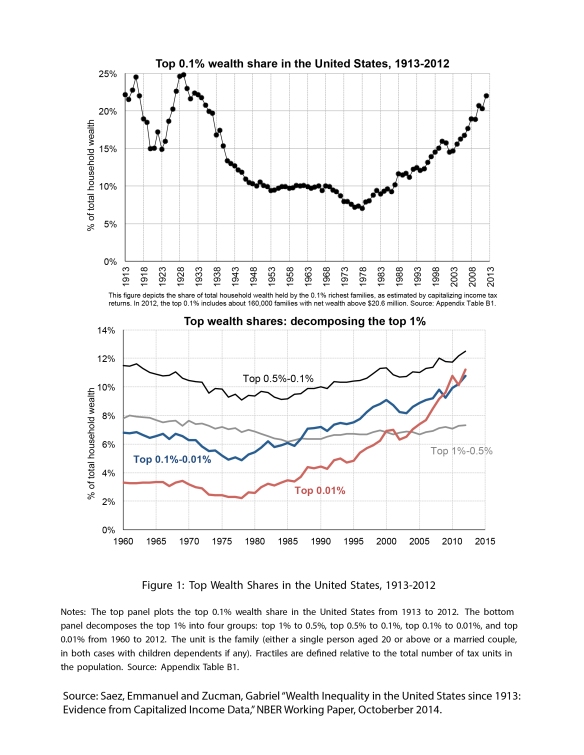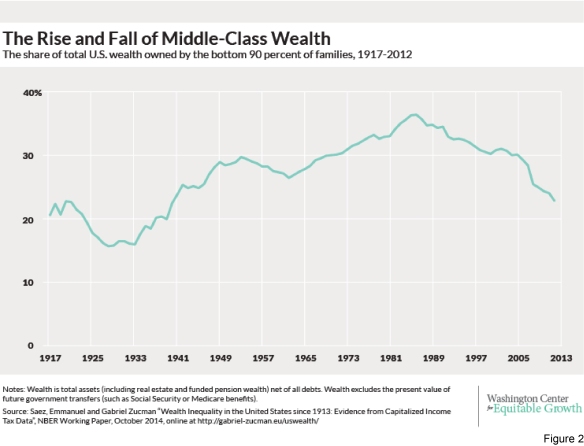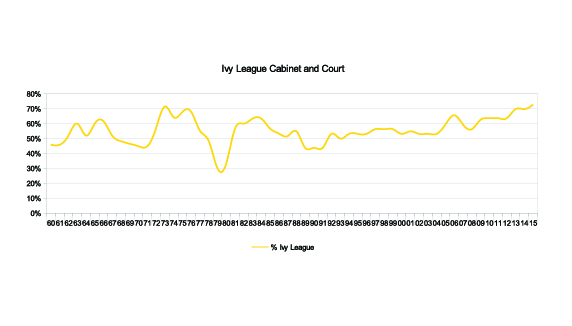The idea behind Chasing Aristocracy is to explore an alternate way of looking at governance in America. The traditional view of governance, that is one that is seen as an ideological battleground between Democrats and Republicans, or Liberals and Conservatives, fails to adequately address what may very well be the defining issue of our time. Wealth inequality has been growing since the early 1970’s in essentially a straight line. There is literally no correlation to the political party affiliations of the President or Congress.
However, there appears to be an interesting curiosity at play. Since 1970, the percentage of the senior members of the Executive and Judicial Branches of the U.S. Government that attended Ivy League schools has increased from 45% to 73%. And even more interesting is that 100% of the current Ivy League senior leaders in the Judicial and Executive Branch attended just one of five schools at some point in their college careers: Columbia, Harvard, Yale, or Princeton in the U.S., or Oxford (in the U.K.).
In the last few years, a new phrase has come roaring in to our lexicon: the 1%. This refers to the top 1% of income earners, which currently in the U.S. means people with annual incomes of about $400,000 per year or above. Most of us have assumed and reluctantly accepted that there is some level of extra influence that these wealthy individuals have on policy and politicians. What we haven’t perhaps understood is that these 1%-ers are literally running the government (some might say running it in to the ground). In reality, it’s a very specific subset of the .5% that’s running the country: those people who by and large have attended the five schools mentioned above: Columbia, Harvard, Yale, Princeton or Oxford, and to a lesser extent the other Ivy League schools-The University of Pennsylvania, Cornell, Brown, and Dartmouth.
Wealth Inequality
In the last year or so, two monumental studies dealing with wealth inequality have been released, building on a momentum of concern going back at least till the financial crisis of 2007-8. Thomas Piketty’s ‘Capital in the Twenty-First Century’ is a nearly 700 page discourse on the concentration of wealth among the very few. And more recently, Emmanuel Saez and Gabriel Zucman’s ‘Wealth Inequality in the United States since 1913’ documents the rise of the .1% and the stagnancy of the middle class.
To understand this dynamic a little bit more, let’s take a look at some interesting data.
The two charts in Figure 1 show something pretty amazing. Clearly, the top .01% are doing very well. The top 1/100th of income earners in the U.S. have been on an amazing roll. And the bottom 90% of Americans-those of us with net assets (total assets minus total liabilities) of about $700,000 or below, have seen their wealth share decline since 1986 (Figure 2 Below). But what’s even more interesting is that at about the .5% level, wealth is stagnant. That means that the average wealth increase of the top 10% of Americans is exclusively attributed to the top .5% of Americans. Think about that for a moment. 99.5% of Americans-those with net assets around 10 million dollars or less, have seen their wealth decrease over the last 30 years. A cursory web search will show a slew of experts and theories as to the cause. But what if there was just one cause?
Figure 3 below represents the percentage of the top positions in the Executive and Judicial Branches that were filled with people who attended Ivy League Schools. While not quite as linear as Wealth Inequality, there nonetheless is an overall trend upwards from the mid 40’s in 1960 to the mid 70’s today. The peaks and dip of the Nixon-Ford-Carter Administrations skew the increasing trend but are certainly not inconsistent with the known historical turmoil of the era. And it’s been 27 years since we had a President who didn’t attend Harvard or Yale.
When we look at all three Figures in tandem, some interesting correlations start to develop:
-The percentage of wealth owned by the top .1% hit its all time low in 1978 and the percentage of Ivy League Cabinet and Court hit its all time low in 1979
-The recent wealth decline trend of the bottom 90% started in 1986 and the stable increase in percentage of Ivy Leaguers started in 1989
-The most recent low in the percentage of Ivy Leaguers occurred in 1989-91, and started its rise in 1992. This unabated rise has happened entirely under the leadership of Presidents who attended Yale or Harvard-Bush Sr., Clinton, Bush Jr. and Obama
-The 50% line in Figure 3 was crossed 7 times from 1960-1992, averaging once every 4-5 years, suggesting some sort of natural fluctuation-or at least a battle of ideals. It’s been 23 years since the 50% line was crossed, strongly suggesting a purposeful trend.
To be sure, not everyone who attended an Ivy League school is a bad character. In fact, some of the best research in America is being conducted at Ivy League schools. And correlation does not always mean causation. But the fact of the matter remains that wealth inequality has reached enormous proportions, and has done so nearly exclusively while Ivy Leaguers have been in charge.
A lifetime of Coddling
At the very least, from the time they are 17 or 18, Ivy Leaguers are told they are the special ones, that they are part of an exclusive club that takes care of each other, that they can be guaranteed at minimum a six figure income, unrivaled prestige, and precious few closed doors. They’ve been constantly evaluated, tested, and elevated to the highest echelons of schooling. Selective admission has driven their lives for the better part of 12 years, sometimes more, and the exclusivity of their club is on display 24 hours a day. And the vast majority of Ivy Leaguers have had this drilled into their persona from birth, gifted to them by their already privileged parents, and many of the non-privileged students quickly embrace the club and trade their humble past for the allure of a lifetime of privilege.
Is it fair to expect these silver spooned, self proclaimed elitists to have a healthy dose of empathy for the rest of us? More importantly, is it reasonable to expect that these aristocrats will govern fairly?
I find this all, at the very least…curious. And as we shall see, I find myself wondering if maybe these Ivy Leaguers are really more Poison Ivies…







chasingaristocracy.com has potential, you can make your site go
viral easily using one tricky method. Just search in google:
Kimting’s Method To Go Viral
LikeLike